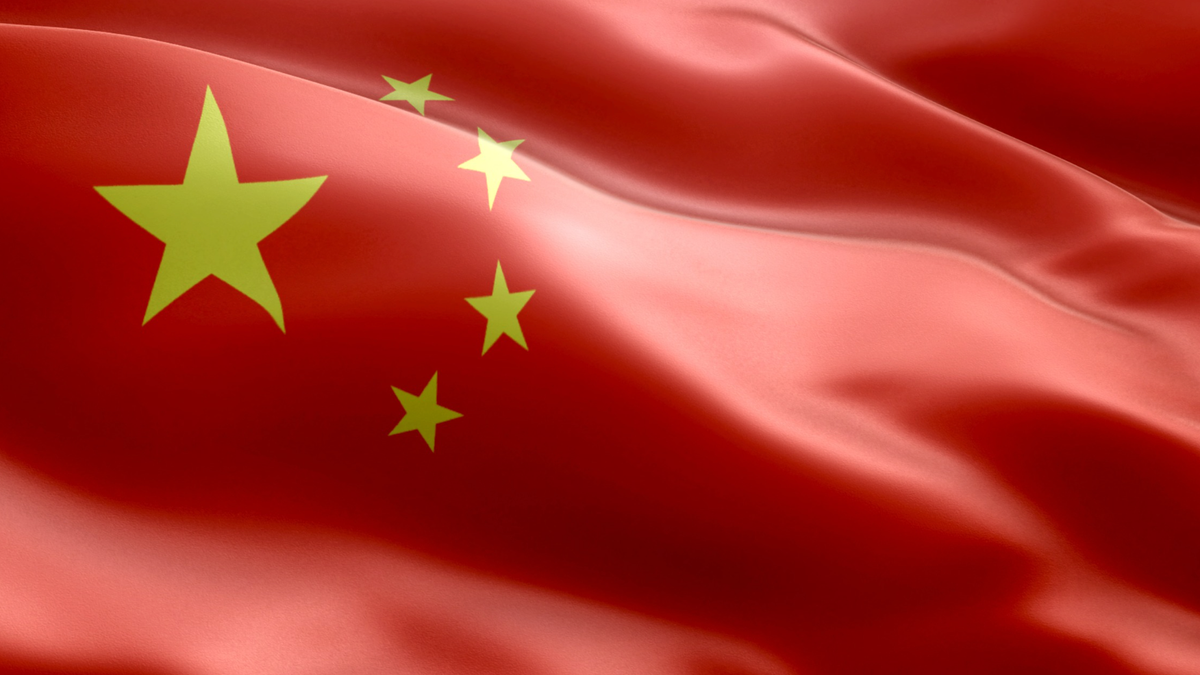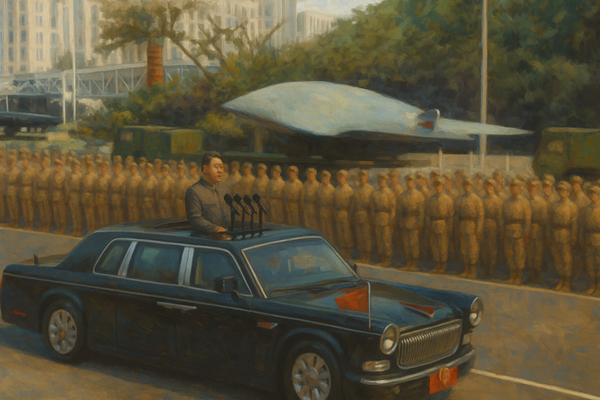🇨🇳 China’s Grand Strategy
Promoting a multipolar world order, comprehensive national rejuvenation through economic modernization, global influence expansion, and regional dominance.

In an era of rapidly shifting global power dynamics, China’s Grand Strategy has emerged as a pivotal framework designed to secure its national interests and redefine its place in the world. Over the next two decades, Beijing’s strategic blueprint is aimed at not only asserting regional dominance but also reconfiguring the international order to better reflect its economic, political, and military might. This article dissects the components of China’s Grand Strategy—from its overarching vision and core objectives to its detailed operational tactics involving the DIME (Diplomatic, Informational, Military, Economic) framework, regional focus, and resource allocation. Moreover, it examines the phased approach for implementation and the domestic implications that underline the intrinsic link between foreign policy and internal societal cohesion.
Vision & National Interest
At the heart of China’s Grand Strategy is a clear vision: to restore China to a position of central global influence, reflective of its historical status as a leading civilization. Over the next 10–20 years, this vision entails transforming China into a robust global power that is not only economically formidable but also strategically independent. The nation aspires to be a guarantor of regional stability and an architect of a new world order that aligns with its values and interests.
Defining National Interests
China’s national interests are multi-dimensional and deeply interwoven with its domestic priorities. They include:
• Economic Prosperity and Technological Advancement: Ensuring sustainable growth by modernizing its industrial base and investing in cutting-edge technology, thereby reducing reliance on external innovations.
• Security and Stability: Safeguarding national sovereignty and territorial integrity while managing internal dissent and external challenges, such as regional conflicts or cybersecurity threats.
• Cultural Renaissance and Ideological Influence: Promoting Chinese culture and the political model as viable alternatives to Western liberal democracy, thereby extending its soft power.
• Regional Dominance and Global Governance: Establishing leadership within Asia while reshaping international institutions and alliances to reflect its interests, particularly in areas like trade, climate change, and security.
By aligning these interests with its long-term vision, China aims to create a stable domestic environment that supports its international ambitions and underpins its grand strategic framework.
Core Strategic Objectives
The Grand Strategy is underpinned by a set of specific goals that reflect both the internal imperatives and the external opportunities and threats China faces. These core objectives can be categorized across several key domains:
1. Economic Modernization and Global Integration:
• Innovation and Technology: Prioritize advancements in artificial intelligence, 5G telecommunications, quantum computing, and renewable energy.
• Belt and Road Initiative (BRI): Expand infrastructure and trade networks across Asia, Africa, and Europe to secure critical supply chains and open new markets.
• Domestic Market Reforms: Enhance domestic consumption and reduce over-reliance on export-driven growth.
2. Military Modernization and Strategic Defense:
• Force Modernization: Upgrade military hardware and integrate advanced cyber and space capabilities.
• Regional Deterrence: Strengthen military presence in the South China Sea, East China Sea, and along the borders to deter external threats.
• Power Projection: Develop capabilities that allow China to operate effectively beyond its immediate geographic neighborhood.
3. Diplomatic and Informational Outreach:
• Soft Power Expansion: Increase cultural, educational, and media exchanges to improve China’s global image.
• Multilateral Engagement: Engage actively in international organizations to promote norms and standards favorable to its interests.
• Strategic Narratives: Shape global discourses by emphasizing principles such as sovereignty, non-interference, and economic cooperation.
4. Environmental and Social Governance:
• Sustainable Development: Invest in clean energy and environmental protection to mitigate climate change risks.
• Social Stability: Ensure that economic reforms and modernization do not exacerbate domestic inequality, thereby maintaining social cohesion.
National Context: Assessing Global and Regional Threats and Opportunities
China’s strategic calculus is deeply influenced by the international context in which it operates. A comprehensive analysis reveals a complex interplay of threats and opportunities, often best visualized through a SWOT framework.
SWOT Analysis
• Strengths:
• Economic Powerhouse: With one of the world’s largest economies, China possesses immense financial resources and a robust industrial base.
• Technological Ambition: Substantial investments in research and development have positioned China as a future leader in innovation.
• Centralized Governance: The Chinese Communist Party’s (CCP) centralized decision-making process allows for rapid implementation of policy initiatives.
• Strategic Geography: Its geographical positioning allows China to influence key trade routes and maintain a significant presence in the Asia-Pacific region.
• Weaknesses:
• Demographic Challenges: An aging population poses long-term challenges to economic growth and labor force vitality.
• Economic Imbalances: Over-reliance on export-led growth and real estate sectors may lead to vulnerabilities.
• Domestic Disparities: Persistent inequalities between urban and rural areas can undermine societal cohesion.
• Environmental Concerns: Pollution and resource constraints necessitate a balance between industrial growth and sustainable development.
• Opportunities:
• Emerging Markets: Expanding trade and investment in developing regions through initiatives like the BRI.
• Technological Innovation: Leveraging advancements in AI, big data, and green technologies to leapfrog development stages.
• Global Governance Reform: Advocating for a multipolar world order that diminishes the Western-dominated international system.
• Cultural Outreach: Promoting Chinese culture and values to build soft power and influence global narratives.
• Threats:
• Rising Powers: The strategic rivalry with the United States and other rising powers poses challenges to China’s regional aspirations.
• Regional Instability: Ongoing disputes in the South China Sea, Taiwan Strait, and border regions risk sparking localized conflicts.
• Cyber and Information Warfare: Vulnerabilities in cyberspace expose China to espionage and interference from rival states.
• Global Pandemics and Environmental Risks: Health crises and climate change may disrupt economic growth and strain public resources.
By addressing these factors, China’s Grand Strategy aims to turn potential challenges into avenues for growth while mitigating inherent risks through calculated investments and reforms.
Instruments
To realize its strategic objectives, China employs a robust suite of instruments that align with the DIME framework. This multifaceted approach ensures that its grand strategy is implemented effectively across diplomatic, informational, military, and economic domains.
Diplomatic Tools
China has increasingly adopted proactive diplomacy to secure its interests globally. Key initiatives include:
• Bilateral and Multilateral Engagement: Strengthening ties with regional powers and participating actively in global institutions such as the United Nations, the World Trade Organization, and the Shanghai Cooperation Organization.
• Economic Diplomacy: Using trade agreements, investment initiatives, and infrastructure projects (notably under the BRI) to cultivate alliances and foster interdependence.
• Cultural Diplomacy: Promoting Chinese language, art, and cultural exchanges to build a favorable international image.
Informational Tools
In the age of information, controlling the narrative is critical:
• Media Influence: State-run media outlets and digital platforms are used to disseminate China’s perspectives and counteract criticism from rival states.
• Cyber Capabilities: Investment in cybersecurity not only protects domestic networks but also allows for strategic offensive capabilities.
• Public Diplomacy: Initiatives that project an image of a responsible global leader, emphasizing China’s contributions to global development and climate change mitigation.
Military Tools
The modernization and expansion of the People’s Liberation Army (PLA) are central to ensuring national security and projecting power:
• Modernization Programs: Development of advanced fighter jets, naval vessels, missile systems, and cyber warfare capabilities.
• Regional Military Presence: Establishing military bases and conducting joint exercises in strategic regions to reinforce deterrence.
• Asymmetric Warfare: Investing in unconventional warfare strategies, including information operations and space-based capabilities, to offset conventional military disadvantages.
Economic Tools
China’s economic prowess underpins much of its grand strategy:
• Investment in Infrastructure: Domestic and international infrastructure projects that bolster connectivity and secure trade routes.
• Technological Innovation: Funding research and development to ensure technological leadership in sectors critical to national security.
• Financial Instruments: Utilization of state-owned enterprises (SOEs) and sovereign wealth funds to drive economic growth and expand influence abroad.
Regional Focus and Strategic Partnerships
A cornerstone of China’s Grand Strategy is its emphasis on regional influence and strategic alliances. By leveraging both traditional and innovative partnerships, China aims to construct a network of relationships that buttress its strategic objectives.
Regional Focus
China’s regional strategy primarily focuses on:
• Asia-Pacific Dominance: Securing influence over key maritime routes and neighboring countries to safeguard economic interests and national security.
• Border Stability: Ensuring a stable environment along its extensive borders, particularly with India, Russia, and Central Asian states.
• Global Reach: Expanding its presence in Africa, Latin America, and Europe through trade, investment, and infrastructure projects, thereby extending its influence far beyond its immediate geographic vicinity.
Strategic Partnerships
China’s approach to international alliances is multifaceted:
• Formal Alliances and Defense Pacts: While not as reliant on formal alliances as some Western nations, China has fostered strategic partnerships through multilateral frameworks like the Shanghai Cooperation Organization and regional security dialogues.
• Key Bilateral Relations:
• Russia: A strategic partner that offers military and energy cooperation, counterbalancing Western pressure.
• ASEAN Countries: Building economic and security partnerships with Southeast Asian nations to manage territorial disputes and promote regional stability.
• Emerging Economies: Establishing ties with African, Latin American, and Central Asian nations through development aid, trade, and infrastructure investment.
• Multilateral Engagement:
• International Institutions: Active participation in global governance bodies helps shape norms and policies in line with China’s interests.
• Peacekeeping and Climate Initiatives: Contributing to international peacekeeping operations and climate accords, China positions itself as a responsible global leader while subtly expanding its influence.
Resource Allocation
Effectively executing a Grand Strategy requires careful allocation of economic, military, and human capital resources. China’s approach in this arena is characterized by both domestic reforms and strategic investments abroad.
Defense Budget Allocation
• Modernization of Military Capabilities: A significant portion of China’s defense budget is dedicated to modernizing the PLA, developing advanced weaponry, and enhancing cyber and space warfare capabilities.
• Infrastructure Investments: Military spending also focuses on establishing overseas bases, improving logistics networks, and investing in dual-use technologies that support both civilian and military applications.
Investment in Key Industries
• High-Tech Sectors: Investments in semiconductor manufacturing, renewable energy, and artificial intelligence are prioritized to reduce dependency on foreign technology and maintain competitive advantage.
• Infrastructure Development: Domestic infrastructure projects, including high-speed rail, urban development, and smart city initiatives, bolster economic resilience and support broader strategic goals.
• Public-Private Partnerships: Collaborations between the government and private sector accelerate innovation and ensure that critical industries receive the necessary capital and expertise to thrive.
Economic Reforms and Policies
• Market Liberalization: Gradual reforms aimed at increasing market efficiency while maintaining state control over strategic sectors.
• Regulatory Innovations: Streamlining regulations to foster an environment conducive to innovation and foreign investment, thereby integrating China more deeply into the global economy.
• Social Welfare Programs: Policies to reduce domestic inequality and ensure that economic growth translates into broad-based societal benefits, thereby reinforcing national cohesion.
Timing and Sequence: A Phased Approach
The success of any grand strategy hinges on the careful timing and sequencing of its initiatives. China’s strategy is implemented in three distinct phases, each with its own set of priorities and measurable objectives.
Short-Term (0–5 Years)
• Immediate Economic Stabilization and Technological Upgrades:
In the short term, China is focused on consolidating its economic recovery post-global disruptions. Priorities include accelerating technological upgrades, particularly in key sectors like 5G, renewable energy, and biotechnology. Policy reforms aimed at stimulating domestic consumption and reducing vulnerabilities in critical supply chains are also emphasized.
• Diplomatic Outreach and Regional Confidence Building:
China will increase its diplomatic efforts by forging new partnerships and reaffirming existing alliances. This period is marked by a series of bilateral and multilateral engagements designed to build trust, mitigate regional tensions, and assert China’s commitment to regional stability.
• Military Readiness and Cybersecurity Enhancements:
Short-term military reforms will focus on rapid modernization programs and cyber defense capabilities, ensuring that the PLA is prepared to counter immediate threats while setting the stage for more complex long-range projects.
Medium-Term (5–10 Years)
• Expansion of Global Economic Influence:
Over the medium term, China’s strategy envisions the deepening of economic ties through the expansion of the Belt and Road Initiative and further investments in global infrastructure projects. This phase will see an increased emphasis on establishing financial institutions and trade networks that reinforce China’s economic clout.
• Advanced Technological Integration and Innovation Leadership:
The medium-term phase is critical for embedding China as a leader in technological innovation. Significant investments in research and development, partnerships with global tech companies, and the creation of innovation hubs across the country will be prioritized.
• Strengthening Military Power Projection:
As the PLA continues its modernization, medium-term efforts will focus on achieving operational readiness for power projection beyond the immediate region. This includes enhanced training, joint exercises with allied nations, and the development of rapid deployment capabilities.
Long-Term (10–20 Years)
• Establishing a New Global Order:
In the long run, China aims to reshape international norms and institutions to better reflect its interests. This phase involves deep structural changes in global governance, where China’s influence in international organizations and multilateral institutions becomes more pronounced.
• Sustained Economic Leadership and Innovation Ecosystem:
The long-term vision is to create an enduring economic model that not only drives domestic prosperity but also sets the global standard in innovation and sustainable development. By this stage, China expects its economic policies to serve as a template for emerging economies worldwide.
• Comprehensive National Security and Strategic Autonomy:
The culmination of decades of military modernization and strategic partnerships will be realized in a security environment where China enjoys broad strategic autonomy. The long-term goal is to deter external threats effectively while securing a stable, multipolar world order that curbs hegemonic ambitions from rival powers.
Domestic Implications and Societal Cohesion
No grand strategy can succeed without the support and stability of the domestic front. China’s leadership is acutely aware that its international ambitions must be matched by robust internal governance and societal cohesion. Several key areas are under continuous development to ensure that domestic priorities are in harmony with the overarching strategic goals:
• Balancing National Security and Civil Liberties:
As China strengthens its security apparatus, it faces the challenge of maintaining social stability without undermining individual freedoms. The government is implementing policies that seek to strike a delicate balance between robust surveillance and the preservation of social order.
• Investment in Education, Healthcare, and Infrastructure:
Recognizing that human capital is critical to long-term success, China is channeling significant resources into education and healthcare. Modernizing infrastructure not only supports economic growth but also helps bridge the urban–rural divide, ensuring that the benefits of development are distributed equitably.
• Integration of Marginalized Communities:
Economic reforms are accompanied by policies designed to integrate marginalized communities, reducing regional disparities and fostering a sense of national unity. Social programs aimed at alleviating poverty and expanding access to quality services play a crucial role in sustaining internal cohesion.
• Public Discourse and National Identity:
Through cultural initiatives and controlled media narratives, the state reinforces a strong national identity that aligns with its grand strategy. Emphasizing China’s historical legacy and modern achievements, these efforts aim to cultivate a unifying narrative that supports both domestic policy and international aspirations.
Conclusion
China’s Grand Strategy is a multifaceted blueprint designed to secure its position as a leading global power over the next 10–20 years. Anchored in a vision that seeks to restore historical prominence, the strategy intricately weaves together national interests, core strategic objectives, and a detailed assessment of the global context. By employing the DIME framework—leveraging diplomatic outreach, informational control, military modernization, and economic investment—China is poised to navigate an increasingly complex international environment.
The regional focus and strategic partnerships not only bolster China’s influence in the Asia-Pacific but also extend its reach to emerging markets across Africa, Latin America, and Europe. Thoughtfully allocated resources underpin the ambitious agenda, ensuring that military modernization, technological innovation, and infrastructure development are pursued in tandem with economic reforms.
Crucially, the phased approach—divided into short-term, medium-term, and long-term initiatives—provides a clear roadmap for implementation, allowing for adaptive flexibility and the sequencing of actions that minimize risks while maximizing strategic advantages. At the same time, the domestic implications of the strategy, ranging from balancing national security with civil liberties to investing in public services and integrating marginalized communities, underscore the essential link between China’s internal stability and its external ambitions.
Ultimately, China’s Grand Strategy is not merely an expression of geopolitical ambition; it is a comprehensive, all-encompassing framework that seeks to harmonize domestic development with international influence. As China continues to assert itself on the global stage, its ability to adapt, innovate, and integrate diverse instruments of power will determine its success in reshaping the world order in the coming decades.
This article has explored the multiple layers of China’s Grand Strategy, from its foundational vision and national interests to the operational tools and phased execution plans that will drive its global engagement. By understanding these elements, one gains insight into the complex interplay of domestic policies and international ambitions that define China’s approach to securing its future.




